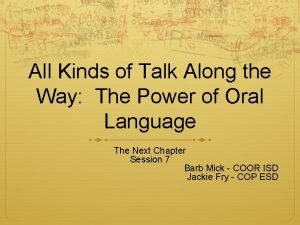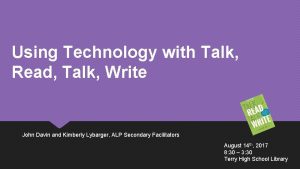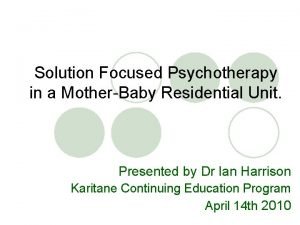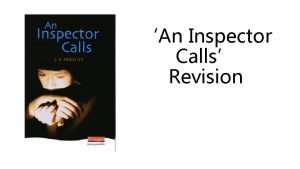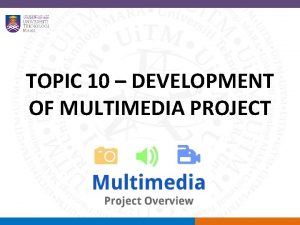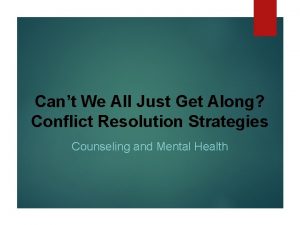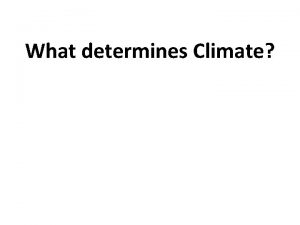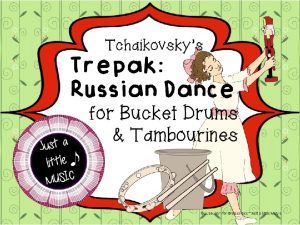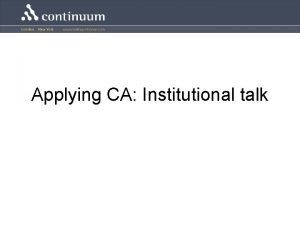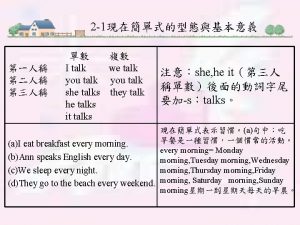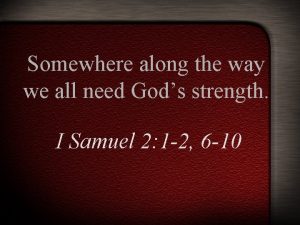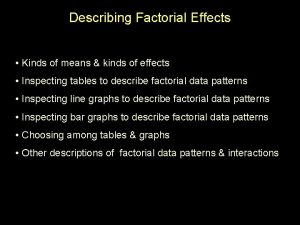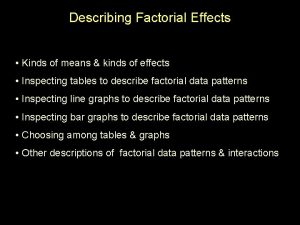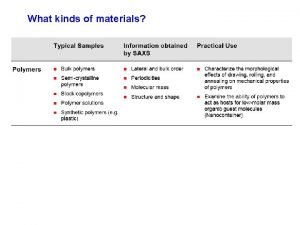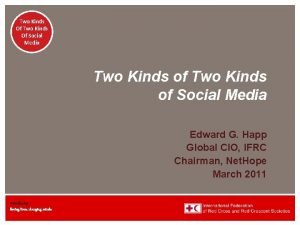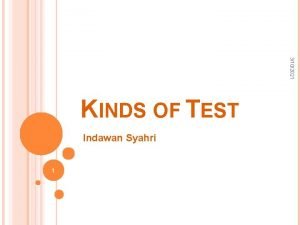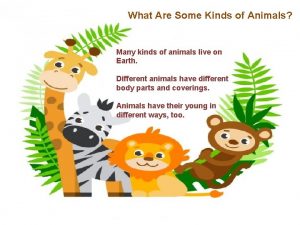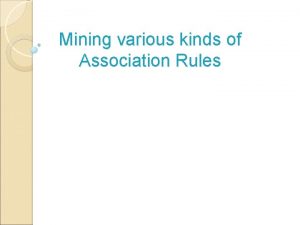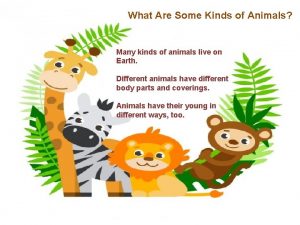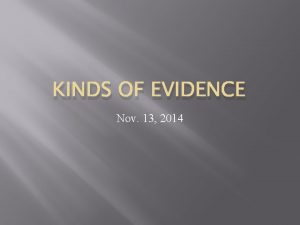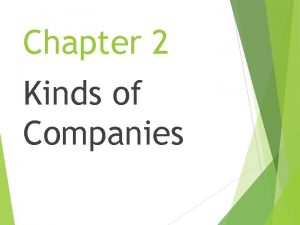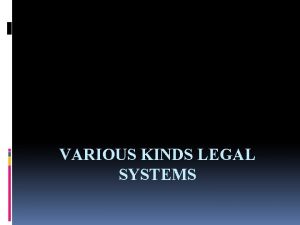All Kinds of Talk Along the Way The













































- Slides: 45

All Kinds of Talk Along the Way: The Power of Oral Language The Next Chapter Session 7 Barb Mick - COOR ISD Jackie Fry - COP ESD

Time for a roadmap check… We’ve introduced assessment, thought about our literacy histories and those of our students, looked at the developmental progression of readers and how to determine the level of our students, and taken a deeper look at comprehension. We looked at writing from a number of angles, and began to practice assessing our students’ writing. We’ve looked more closely at formative assessment and goal setting, and practiced using tools to score our students’ writing and confer with individual writers. Tonight we will take a close look at the foundation of comprehension: oral language.

Goals for Session 7 Understand the foundational nature of oral language for thinking and comprehension Review the Common Core Speaking and Listening Standards Learn about the MLPP Oral Language assessments for Receptive and Expressive Language and how to use them to inform instruction Understand the continuum of talk: basic oral language, conversation, dialogue, discourse Understand how academic discourse is addressed by the Common Core and how it promotes content comprehension

Your Turn… 1. Appoint a time-keeper at your table. (You will have 15 minutes total for discussion, so make sure everyone gets a chance to share. ) 2. Share your student writing and your assessment of that writing with the others. Share your conferring notes and talk about how you chose your teaching point for each of the students. 3. Compare your experience with narrative writing to that of argumentation and informational writing. 4. What patterns are you seeing with your class? What is still hard?

Oral Language What does this tell you about Oral Language? http: //themoth. org/posts/stories/an-indomitable-spirit

Quick Write a summary of An Indomitable Spirit List the skills needed to effectively complete this task.

Definition Oral Language relates to the student’s ability to effectively make meaning and use language conventions through speaking, listening, and viewing. Oral Language includes the receptive and expressive aspects of language.

Rationale Oral language is the basis of literacy. It is in fact crucial to a child’s literacy development and includes listening speaking, reading, writing, and viewing. Oral language is an important link in the process of student learning and thinking development. Throughout life, oral language skills remain essential for communication of ideas and intelligent conversation. Teachers need to understand the necessary skills and provide plenty of opportunities for students to develop them. It deserves designated class time.

And, furthermore… Child psychologist Jerome Bruner wrote, “We are storytelling creatures, and as children we acquire language to tell those stories that we have inside us. ” Oral language is the foundation for comprehension. Oral language provides the bridge to effective writing.

The Speaking & Listening Standards (CCSS) Individually, highlight the key words in each of the standards for your grade. (If you are a specialist or principal, choose one grade to examine closely. ) You will have 7 minutes to do this activity. Talk at your table about what you notice. 5 minutes Each table should be ready to share one thought about the standards in the large group discussion.

Frayer’s Model: What is IS Teacher allows students to have lots of opportunities to talk Teachers discover students’ thinking process and prior knowledge Teachers create a risk free environment Teachers encourage students to ask questions Teachers model and encourage students to say things in different ways, inviting elaboration and rewording

Teachers themselves are good models of oral language Teachers extend students’ thinking by building bridges from known to new information Teachers purposefully and directly teach the skills of discourse and collaboration Teachers provide opportunities to talk in whole group, small group, and with partners across the curriculum

Don’t forget the GRR!

Frayer’s Model: What is it NOT? The teacher doing all the talking Just show and tell Just “turn and talk” with no purpose or accountability Just answers to literal questions A subject in itself

How do you use oral language? Look over the handout, Reasons to Converse in School Individually, select 2 reasons from the front and 2 reasons from the back. Name the specific times you might use that particular reason to build oral language skills. Write those specific times in each box you chose. (8 minutes) Then share at your table. (2 minutes – quick share) Be ready to contribute to the master document as it is filled in as a word document. (We’ll share this completed document with you. )

Teaching Oral Language Skills Explictly We all know about the “thirty million word gap” We can’t influence the experiences students have before they enter our classrooms, but we can be more deliberate about the language experiences they have while in it.

The Importance of Retelling Increases both the quantity and quality of comprehension Requires a number of skills, including inferring, determining importance, visualizing, and summarizing Enhances language development and communication skills Gives readers an opportunity to process what they have read by organizing the information and explaining it to others

The Importance of Retelling…continued Develop storytelling language Organize thought into a sequential story Pay attention to detail Recite sentences of different length Lay an important foundation for understanding story elements Retrieve and pronounce words

Elizabeth Sulzby’s Stages of Emergent Storybook Reading Select a storybook; read this same book four times during a two week period. The tone of the reading should be of “sharing the book”. Have a brief discussion about the book each time, becoming increasingly more sophisticated. Get ready to assess.

Sulzby Assessment Always say, “Read me the book. ” Use plenty of wait time Have an encouraging look on your face If the child is reading silently, let them finish a page, then say, “Now read so I can hear it. ” If a child initially refuses, prompt with “It doesn’t have to be like grown-up reading. Just do it your way. ” If a child still refuses, read a bit of the story, but always return control to the child by saying, “Now it’s your turn. ” End with a praise of the story and a thanks for sharing, such as “What a wonderful story. Thank you for sharing it with me. ” Avoid saying, “Good job” or similar phrases which imply judgment.

The authors of Oral Mentor Texts asked… What if their OWN stories became mentor texts?

“Stories are powerful magic in every culture. They conjure up a past that predates our existence. They reanimate experiences that lie dormant in our psyche, events we have moved beyond. They connect us to one to another, a quilt of humanity. Stories keep relationships and emotions and experience alive and thriving. Stories help us understand ourselves and others. Stories tether us to place, ground us with a sense of belonging. Stories serve as touchstones when we have difficult decisions to make. They are mentors from our past, our culture, and our shared experience with trusted others. We return to our stories over and over throughout our lives like a child with a security blanket. ” Lester Laminack, in the foreword of Oral Mentor Texts

Your Turn Select a story from the year in your classroom. Quickly write it down. It should be 7 – 10 sentences long. (You only have 7 minutes to write it and share it orally)

Oral Mentor Texts Throughout the Year Finding a building an oral class story begins on day one. The teacher always creates the oral mentor story in order to build in the reading and writing teaching points. The initial story is a simple event the class has experienced during the first few days of school – getting in line for lunch, walking to the gym, getting a drink at the water fountain. This story is short, sequenced, and told as if it were a story book.

Building the Story The teacher writes it down so that it remains constant, but the story is always told orally. Be sure to have a clear idea about what you want the story to teach. Use seven to ten sentences. Keep sentence structure simple, but use a variety of structures. Include dialogue. Include students’ names. Use precise language appropriate for your students’ developmental level.

Learning and Practicing the Class Story Students should be eager to practice their class stories; the work should be engaging. They should incorporate symbols and gestures to help them retrieve words. They should tell longer and more sophisticated stories as the year progresses. They should retell stories with accuracy. They should pay attention to phrasing and expression. They should use an appropriate rate. Every child should be able to participate successfully. The class story should help children practice convention in the air. Students should use a strong, clear voice and make eye contact with their audience. There should be opportunities throughout the day to practice telling the story as a class.

How Oral Stories Evolve Across the Year

Structures for Learning a Class Story 1. Echo telling 2. Adding symbols 3. Adding gestures 4. Choral telling

Structures for Practicing a Class Story Get good at telling one sentence/incident at a time. Tell it in a circle. Use popcorn telling. Tell it like a book. Tell it to a partner. Tell it to an audience.

Turn and Talk How can you see using this in your classroom? Make a list of stories you could use from common experiences in your classroom this year. (5 minutes)

Thinking, Learning, and Conversations Learning is a consequence of thinking. Good thinking is not only a matter of skills, but a matter of disposition. The development of thinking is a social endeavor. (Ritchhart & Perkins, 2008) Conversations make thinking visible.

What Does Comprehension Look Like? Coming to know Taking some risks Hypothesizing and speculating Attempting to make connections Using your own knowledge and the knowledge of others Using intuition and evidence Conversing (talking, discussing, listening) Persevering; working through

Why Talk? Talk forces us toward clarification and understanding. Talk instantiates ideas in our own language. Talk allows us to build on the insights and perspectives of others. Talk makes us less egocentric in our thought and helps us entertain alternative interpretations and perspectives. Talk promotes civility. Talk is aesthetically pleasing.

Monologic vs Dialogic Talk Monologic talk: authoritative presumes listener will agree with or learn from speaker teacher-centered does not encourage questions implies one right answer

Monologic vs Dialogic Talk: speaker becomes listener & listener becomes speaker new ideas emerge through give-and-take both responsible to bring clarification to the table student-centered

Conversation, Discussion, Dialogue is a unique way of thinking and talking together. Dialogue is a combining of ideas that requires thoughtful listening and responding, allowing participants to collaborate and the construction of meaning to become the primary focus. Because dialogue is so incredibly purpose driven, we like to refer to it as PURPOSEFUL TALK. Purposeful talk is a social process that requires students to actively engage with ideas, think out loud together, and work to a co-construction of those ideas.

Paradigm Shifts What We’re Pushing Away From, and Why FROM TO FIXED VIEW OF INTELLIGENCE CONDITIONS THAT ENABLE LEARNED INTELLIGENCE INDIVIDUAL EFFORT LEARNING COMMUNITIES TRANSMISSION THEORY A CONSTRUCTIVIST THEORY OF LEARNING RIGHT ANSWERS VALUING IDEAS TESTING AS ASSESSMENT TALKING AS ASSESSMENT

Academic Conversations Oral Language is a cornerstone on which we build our literacy and learning throughout life. Unfortunately, oral language is rarely taught in depth after third grade. Of particular concern is oral academic language.

The First Days 1. Discuss the purpose of conversation skills 2. Go over what conversation is and is not 3. Model bad conversation behaviors in a drama or fishbowl setting 4. Emphasize the ongoing habit of sticking to the destination, the purpose, the main topic 5. Establish shared conversation norms

Five Core Skills of Academic Conversation 1. Elaborate and clarify 2. Support ideas with examples 3. Build on and/or challenge a partner’s idea 4. Paraphrase 5. Synthesize conversation points

Oral Language Assessment WHAT: Oral Language includes the expressive (speaking) and receptive (listening) aspects of language. These assessments relate to the student’s ability to effectively make meaning and use language conventions through speaking, listening, and viewing. WHY: Students must have well-developed oral language to effectively participate in literacy tasks.

Oral Language Assessments WHEN: Kindergarten: Throughout the school year during normal classroom routines. Individually with students not exhibiting strong oral language skills. First Grade: Throughout the year during normal classroom routines, using the formal expressive language rubric; throughout the year using the informal receptive language checklist. Second – Fifth Grade: Throughout the year during normal classroom routines, during presentations, and small group discussions such as literature circles, reading workshop, content discourse, etc.

Time to process At your table, look through the Oral Language packet which includes the Expressive and Receptive Language Rubrics. Read over the directions and examine the rubrics for your grade level. Then have a conversation at your table to answer the following: 1. 2. 3. 4. Who currently uses these assessments? How do they inform your instruction? What is the connection to the CCS? What is the connection to the Smarter Balanced Assessments? Be ready to share your comments and questions.

Your Assignment 1. Use the Oral Language Rubrics for Receptive and Expressive Language for your grade level with your case study students. 2. Fill out the assessment forms for each case study student. 3. Design a lesson based on the information from Session 7. Do the lesson with your class and take notes on how it went. 4. Fill out the Reflection for Session 7. 5. Bring your Oral Language assessment forms, a copy of your lesson, and your lesson notes to the next session.

Ticket Out the Door & Wrap Up Make sure to clean up your area and recycle your water bottles. Please complete your Exit Ticket and turn it in as you leave. Leave your nametag in the box on the table in the hallway. Our next meeting will be: Fueling Up on Words: Vocabulary, Phonics, and Spelling Thank you for your hard work, thoughtful contributions, and professionalism.
 Walk this way talk this way
Walk this way talk this way Kinds of talks
Kinds of talks Talk, read talk write template
Talk, read talk write template Amateurs discuss tactics professionals discuss logistics
Amateurs discuss tactics professionals discuss logistics Problem talk vs solution talk
Problem talk vs solution talk Name 3 points
Name 3 points An inspector calls act 1 revision
An inspector calls act 1 revision The way some of these cranks talk
The way some of these cranks talk Who develops multimedia projects
Who develops multimedia projects The brook explanation stanza by stanza
The brook explanation stanza by stanza Can't we all just get along
Can't we all just get along All kinds of shapes
All kinds of shapes What are the market forms and cuts of meat
What are the market forms and cuts of meat There are many kinds of sport
There are many kinds of sport What determines climate
What determines climate I love nn
I love nn What's a frequency table
What's a frequency table Two way anova
Two way anova Threaded binary tree definition
Threaded binary tree definition Perbedaan two way anova dan one way anova
Perbedaan two way anova dan one way anova One way two way anova
One way two way anova One way anova vs two way anova
One way anova vs two way anova Two way anova adalah
Two way anova adalah Principles of conventional software engineering
Principles of conventional software engineering This way that way forwards backwards over the irish sea
This way that way forwards backwards over the irish sea Jesus leads me all the way
Jesus leads me all the way 一路我蒙救主引领
一路我蒙救主引领 All the way until the end
All the way until the end Hình ảnh bộ gõ cơ thể búng tay
Hình ảnh bộ gõ cơ thể búng tay Ng-html
Ng-html Bổ thể
Bổ thể Tỉ lệ cơ thể trẻ em
Tỉ lệ cơ thể trẻ em Voi kéo gỗ như thế nào
Voi kéo gỗ như thế nào Tư thế worm breton
Tư thế worm breton Hát lên người ơi
Hát lên người ơi Các môn thể thao bắt đầu bằng tiếng nhảy
Các môn thể thao bắt đầu bằng tiếng nhảy Thế nào là hệ số cao nhất
Thế nào là hệ số cao nhất Các châu lục và đại dương trên thế giới
Các châu lục và đại dương trên thế giới Công của trọng lực
Công của trọng lực Trời xanh đây là của chúng ta thể thơ
Trời xanh đây là của chúng ta thể thơ Cách giải mật thư tọa độ
Cách giải mật thư tọa độ 101012 bằng
101012 bằng độ dài liên kết
độ dài liên kết Các châu lục và đại dương trên thế giới
Các châu lục và đại dương trên thế giới Thể thơ truyền thống
Thể thơ truyền thống Quá trình desamine hóa có thể tạo ra
Quá trình desamine hóa có thể tạo ra

